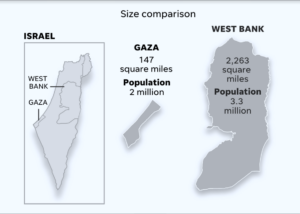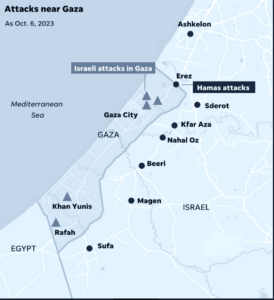
Intense fighting is raging in Israel and Gaza after the terror outfit Hamas launched thousands of rockets into Israel and gunmen infiltrated Southern Israel. “We are at war, and we will win it,” Israeli Prime Minister Benjamin Netanyahu said on Saturday.
The current fighting is the worst the area has seen since 2021, but it is pertinent to note that it is part of a complex, bitter conflict that reaches back to the First World War. Though its borders have shifted over the years, Palestinian territories used to be what is now Israel, Gaza and the West Bank. The history, culture, and identity of both Israeli Jews’ and Palestinian Arabs’ are linked to these territories and to the ancient city of Jerusalem, which is considered one of the “most bitterly contested cities on earth.”
DISPUTED TERRITORY

GAZA: The Gaza Strip is home to about 2 million Palestinians, many displaced after leaving or being driven from Israel during the War of Independence.
WEST BANK: The West Bank is east of Israel. About 3 million Palestinians live there, most of them Muslim Arabs. The West Bank contains a number of Jewish holy sites, which are visited by thousands of pilgrims every year.

EAST JERUSALEM: The holy city of Jerusalem itself is a divided, disputed city. It was sectioned in two after the 1948 Arab-Israeli war. Israel controlled the western portion and Jordan controlled the east. Israel captured the entire city in the 1967 Six-Day War. Jerusalem’s ownership is disputed, Israeli officials claim it as the undivided capital of Israel. In 2017, the Donald Trump administration moved the United States Embassy in Israel to Jerusalem from Tel Aviv, a formal recognition of Jerusalem as the capital. However, most nations do not acknowledge Jerusalem as belonging to either Israelis or Palestinians.
CONFLICTING SIDES
HAMAS: Hamas is the largest Palestinian militant group and has claimed responsibility for the rockets fired from Gaza at Israeli cities in the fighting that began on Saturday morning. The outfit was founded in 1987 during the first Palestinian uprising against Israeli occupation of Gaza and the West Bank and has controlled Gaza since winning elections in 2007. According to Hamas militants, the group is committed to the destruction of Israel and is considered a terrorist group by the US, the United Kingdom and other nations.
ISRAELI DEFENSE FORCES: The IDF is the combined armed forces of Israel, including army, navy and air force. It was established in 1948, two weeks after Israel declared itself a state.
THE TIMELINE
1947: The United Nations votes to divide Palestine into separate Jewish and Arab states and make Jerusalem an international city. Arabs reject the plan, which is later dropped.
1948: After the British Mandate expires on 14 May, the Jewish People’s Council meets in Tel Aviv and establishes the State of Israel. The US officially recognises the new nation later that day; the USSR acknowledges it three days later.
1949: The Armistice Agreements is a UN-mediated attempt to bring peace to Palestine. Israel signs agreements with Egypt, Jordan, Syria and Lebanon to reach a formal peace treaty within six months, but the effort ultimately fails.
1956: Egypt nationalises the Suez Canal and bars Israeli ships from using it and the Straits of Tiran, another shipping route. Israel, aided by Britain and France, invades Egypt. The Soviet Union, an ally of Egypt, threatens nuclear retaliation, and the US pressures British, French and Israeli forces to withdraw. The UN deploys a peacekeeping force.
1964: The Palestine Liberation Organisation, a group with the goal of uniting Arab groups and liberating the Palestinian territories through armed struggle, is formed in Egypt.
1967: The Six-Day War grows out of the Suez Canal conflict. Egypt orders the UN force to leave, closes the Straits of Tiran to Israel again, and plans a secret attack against Israel. In a preemptive strike, Israel attacks Egypt and later Jordan and Syria, capturing Gaza, the West Bank, East Jerusalem, the Golan Heights and the Sinai Peninsula.
1973: The Yom Kippur War starts with Egypt and Syria attacking Israel on Yom Kippur, the holiest day of the Jewish year. The war is an attempt to reverse the defeat of the 1967 war. Caught unaware, the Israelis counterattack and win. The US helps secure disengagement agreements from combatants, laying groundwork for future peace efforts.
1979: The Camp David Accords, an Israeli-Egyptian peace deal, is set up by President Jimmy Carter and signed by Egyptian President Anwar Sadat and Israeli Prime Minister Menachem Begin. Israel begins gradual withdrawal from the Sinai.
1987: Palestinians stage the first of two uprisings, or intifadas, in Gaza, Israel and the West Bank, using mass boycotts, civil disobedience and attacks on Israelis. Over 50 Israeli civilians are killed. The intifada lasts more than five years, ending in September 1993. The IDF kills 1,070 Palestinians, including 237 children, according to B’Tselem, an Israeli human rights organisation. Jewish settlers kill 54 Palestinians. The US and the UN criticise Israel’s use of lethal force.
1991: In response to the intifada, the Madrid Conference, a historical gathering of all participants in the Arab-Israeli conflict, is chaired by the US and Russia.
1993: Oslo I, known as the Declaration of Principles, is signed by Israeli Prime Minister Yitzhak Rabin and Palestinian leader Yasser Arafat. It establishes a timetable for a Middle East peace process.
1995: Oslo II is signed, a second agreement in which the Palestine Liberation Organization recognizes the state of Israel and Israel allows Palestinians limited self-government in Gaza.
2000: US President Bill Clinton, Israeli Prime Minister Ehud Barak and Palestinian leader Yasser Arafat gather at the Camp David summit, a meeting intended to end hostilities. It ends without an agreement. Palestinians, frustrated over failures to create a Palestinian state, begin the second intifada in September, which lasts until February
2005: An estimated 3,100 Palestinians and nearly 1,000 Israelis are killed.
2005: Israel withdraws from Gaza but retains control.
2007: Hamas, the militant Palestinian group, wins elections in Gaza.
2008: Israel launches a major military campaign against Hamas in Gaza after increased rocket fire from militants. The fighting ends on 18 January 2009, with 1,440 Palestinians and 13 Israelis killed.
2012: Israeli forces kill Ahmed Jabari, a Hamas military chief, in a missile strike. The strike is part of an Israeli operation to eliminate weapons and militants in Gaza. Hamas says the killing has “opened the gates of hell.”
2014: Hamas kidnaps and kills three Israeli teens in the West Bank, igniting the Gaza War, in which rocket attacks and airstrikes kill 2,251 Palestinians and 73 Israelis. A senior Hamas leader praises the kidnapping and says it was intended to spark a new Palestinian uprising. The war lasts 50 days and ends with a truce. A UN report said both sides may have committed war crimes, which Israel and Hamas dispute.
2017: The Trump administration says it will move the US Embassy in Israel to Jerusalem from Tel Aviv, in effect an official U.S. recognition of Israel’s claim to the city. The embassy is relocated in 2018.
2018: Protests break out on the Gaza-Israeli border as the US Embassy is relocated. Demonstrators throw explosives and rocks across barrier fences and are met with gunfire and tear gas. At least 58 Palestinians are killed, the Gaza health ministry says.
2021: Fighting erupts again as Israeli police raid the Al-Aqsa Mosque in Jerusalem on 13 April, the first night of the Muslim holy month of Ramadan, and disconnect speakers broadcasting prayers as Reuven Rivlin, the Israeli president, is speaking at the Western Wall, a site sacred to the Jewish people. Police then close a nearby plaza, a popular gathering place. Palestinians and Jews begin attacking one another, and Israeli police raid the mosque on 7 May. Hamas and other militants fire rockets into Israel from Gaza on 10 May. Israel counterattacks with airstrikes. A ceasefire went into effect on 21 May. It lasted until 16 June, when Hamas sent incendiary balloons—helium balloons or kites with flammable devices attached—across the Gaza border into Israel. The devices caused 20 ground fires in fields near the border, according to the Israeli fire brigade. Hamas launched the devices after Israeli officials permitted ultranationalist demonstrators to march in Jerusalem.
2022: In the spring and summer of 2022 Israel experienced a string of terrorist attacks that led it to take what it described as preemptive action, including airstrikes targeting senior commanders and weapons depots, against Iran-backed militant groups such as Islamic Jihad. At least 44 Palestinians, including 15 children, were killed in three days of violence in August 2022.
2023: In January this year, Israel launched the first of two raids against the Jenin refugee camp in the West Bank, where it said Palestinian militants and activists were hiding out. The second raid, in July, saw Israel send about 1,000 soldiers, backed by drone strikes, to Jenin to demolish what it characterised as a militant command center.
October 2023: In the biggest offensive in years, dozens of gunmen from the Palestinian militant group Hamas infiltrate southern Israel in a stunning surprise attack that coincided with a major Jewish holiday. Overnight and into the morning, Hamas launched thousands of rockets into Israel. Israel’s national rescue service said at least dozens of people were killed and hundreds wounded.